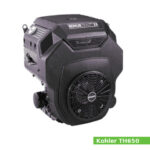
The cylinder bore and the piston stroke are 80.0 mm (3.15 in) and 65.0 mm (2.56 in), respectively. Compression ratio rating is 8.8:1.
The Kohler TH650 engine produced 20.3 PS (14.9 KW; 20.0 HP) at 3,600 rpm of horsepower and 45.1 Nm (4.6 kg·m; 33.3 ft·lb) at 2,500 rpm of torque.
The Kohler TH650 features:
- OHC design
- Cast iron cylinder liners
- Electronic ignition system (CDI)
- Carburetor with fixed main jet
- Mechanical centrifugal governor
- Full pressure lubrication system
- Forced air cooling system
- Recoil or electric starter
General information
| Engine Specifications | |
| Engine model | Triad TH650 |
| Engine type | 4-stroke, OHV, V-Twin |
| Displacement | 653 cm 3 (39.8 cu-in) |
| Max. horsepower | 20.3 PS (14.9 KW; 20.0 HP) at 3,600 rpm |
| Max. torque | 45.1 Nm (4.6 kg·m; 33.3 ft·lb) at 2,500 rpm |
| Cooling system | Forced air |
| Air cleaner | Replaceable high-density paper element |
| Lubricating system | Full pressure |
| Ignition system | Electronic ignition system (CDI) |
| Fuel system | Carburetor with fixed main jet |
| Fuel used | Unleaded gasoline (octane number 86 or higher) |
| Starting system | Recoil or electric starter |
| Governor | Mechanical centrifugal governor |
| PTO shaft rotation | Counterclockwise (from PTO shaft side) |
| Dimensions (L x W X H) | 328 x 400 x 449 mm (12.9 x 15.7 x 17.7 in) |
| Dry weight | 43.0 kg (90.0 lbs) |
Cylinder Block and Head
| Cylinder block | |
| Compression ratio: | 8.8:1 |
| Cylinder bore: | 80.0 mm (3.15 in) |
| Piston stroke: | 65.0 mm (2.56 in) |
| Cylinder head | |
| Valve arrangement: | OHC, belt driven |
| Valves: | 4 (2 per cylinder) |
| Valve head diameter (INTAKE): | 29.180-29.430 mm (1.1488-1.1586 in) |
| Valve head diameter (EXHAUST): | 26.300-26.700 mm (1.0354-1.0512 in) |
| Valve seat angle (INTAKE): | 89° |
| Valve seat angle (EXHAUST): | 89° |
| Valve seat angle (INTAKE): | 45° |
| Valve seat angle (EXHAUST): | 45° |
| Valve steam diameter (INTAKE): | 5.982-6.000 mm (0.2355-0.2362 in) |
| Valve steam diameter (EXHAUST): | 5.970-5.988 mm (0.2350-0.2357 in) |
| Valve lift minimal (INTAKE): | 7.50 mm (0.295 in) |
| Valve lift minimal (EXHAUST): | 7.50 mm (0.295 in) |
Tightening torque specs
| Tightening torque specs | |
| Connecting rod | 11.3 Nm (1.2 kgf·m; 8.3 ft·lb) |
| Electric starter | 7.9 Nm (0.8 kgf·m; 5.8 ft·lb) |
| Oil drain plug | 16.3 Nm (1.7 kgf·m; 12.0 ft·lb) |
| Oil filter | 5.6-9.0 Nm (0.6-0.9 kgf·m; 4.1-6.6 ft·lb) |
| Muffler retaining nuts | 24.4 Nm (2.5 kgf·m; 18 ft·lb) |
| Valve cover | 5.6 Nm (0.6 kgf·m; 4.1 ft·lb) |
| Flywheel | 66.4 Nm (6.77 kg·m; 49 ft·lb) |
| Spark plug | 24.4-29.8 Nm (2.5-3 kgf·m; 18-22 ft·lb) |
| Ignition module | 4.0-6.2 Nm (0.4-0.6 kgf·m; 3-4.6 ft·lb) |
Service Data
| Engine | |
| Maximum speed: | 3600±50 rpm |
| Valve clearance | |
| Intake | 0.013-0.064 mm (0.0005-0.0025 in) |
| Exhaust | 0.076-0.127 mm (0.0030-0.0050 in) |
| Oil system | |
| Lubrication system: | Full pressure |
| Oil type: | API SG, SH, SJ, or higher |
| Recommended oil: | SAE 10W-30 |
| Oil capacity: | 1.4 liters (1.48 US.qts, 1.23 Imp. qts) |
| Fuel system | |
| Type: | Carburetor with fixed main jet |
| Fuel pump: | Pulse type |
| Fuel filter: | In-line |
| Ignition system | |
| Type: | Electronic ignition (CDI) |
| Spark plug: | Champion RC12YC |
| Spark plug gap: | 0.76 mm (0.030 in) |
| Ignition module air gap | 0.200-0.300 mm (0.0079-0.0118 in) |
References
1. Kohler OHC 16,18 HP horizontal crankshaft service manual. Kohler Co. 1997.
2. Kohler Triad OHC TH520-TH650 horizontal crankshaft owner’s manual. Kohler Co. 2004.
 Author:
Author:
Be the first to comment